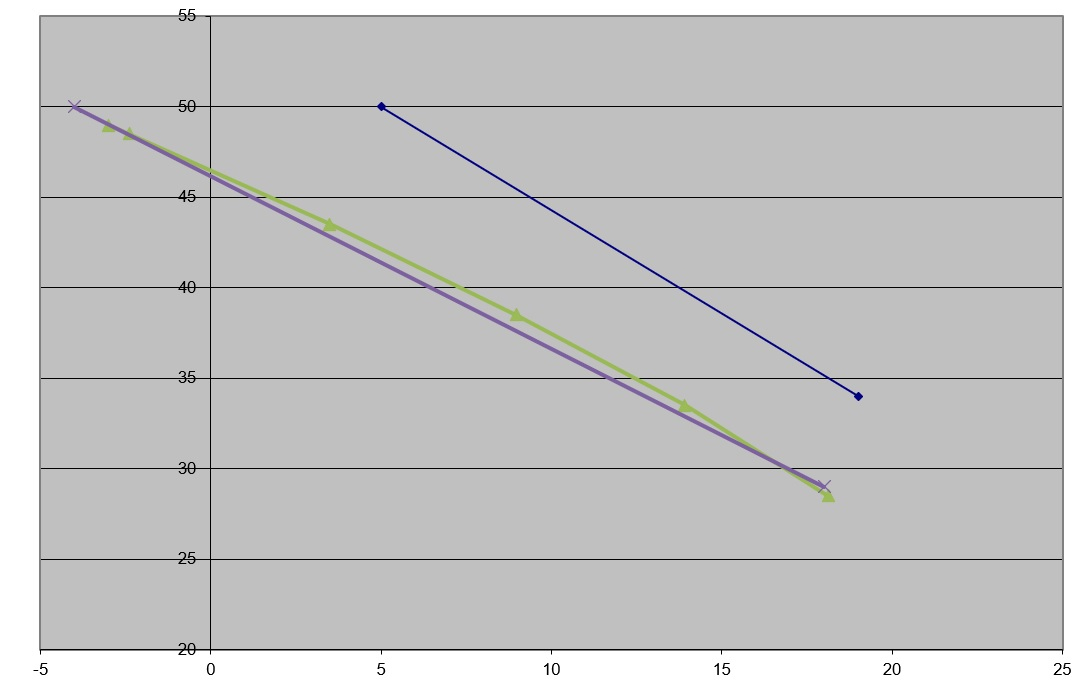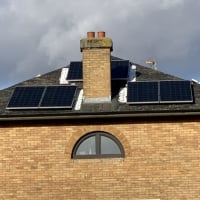We’d like to remind Forumites to please avoid political debate on the Forum.
This is to keep it a safe and useful space for MoneySaving discussions. Threads that are – or become – political in nature may be removed in line with the Forum’s rules. Thank you for your understanding.
The MSE Forum Team would like to wish you all a very Happy New Year. However, we know this time of year can be difficult for some. If you're struggling during the festive period, here's a list of organisations that might be able to help
📨 Have you signed up to the Forum's new Email Digest yet? Get a selection of trending threads sent straight to your inbox daily, weekly or monthly!
Has MSE helped you to save or reclaim money this year? Share your 2025 MoneySaving success stories!
Going green(er) with a Viessmann 200W (& heating efficiency home improvements)
Comments
-
Nope. Off a storage combi but not continuously running water during shower. The services teach you good water conservation & I don't need a shower every day.michaels said:
I'm hoping very much that you have an electric shower...BUFF said:Nov 21 518kWh
Nov 22 44kWh
No changes to boiler, controls or house fabric.
Haven't had the heating on yet this Autumn ...

44kWh is ~ 1000 litres of hot water at delta 30 & 80% efficiency. That's good for ~110 minutes of actual flow at 9l/min.2 -
Ah got it. Essentially, we programmed the curve to ensure a 45 degree flow temperature @ 0 degrees C for the radiators (this usually translates to ~35 @ 10 degrees 55 @ -10 degrees. For UFH, it's 30 degrees @ 0 degrees C with 25 @ 10 degrees and 35 @ -10 degrees C. We do have decent insulation and larger T22 radiators, which have really helped as well. We haven't needed to change this since.michaels said:A 200 system boiler but 11 years old now. Our curve gradient is 1.6 - ie outside temp goes down by one degree, return temp needs to go up by 1.6 to maintain the fixed interior temp. You showed us earlier that your slope is 1.0 which I guess suggests your insulation is better and/or your emitters are bigger. I was just wondering if you were finding that slope was working for you now the temps were getting colder or whether you might need to tweak it a bit steeper?
It's great to hear of another V200 performing well 11 years on.- 10 x 400w LG Bifacial + 6 x 550W SHARP BiFacial + 2 x 570W SHARP Bifacial + 5kW SolarEdge Inverter + SolarEdge Optimizers. SE London.
- Triple aspect. (33% ENE.33% SSE. 34% WSW)
- Viessmann 200-W on Advanced Weather Comp. (The most efficient gas boiler sold)Feel free to DM me for help with any form of energy saving! Happy to help!0 -
Suppose its 0 degrees outside, you want your house to be 20 C and you can achieve that with a mean 40 C radiator temperature (which I assume to be 45 C flow 35 C return). If instead its 10 C outside then your house will lose heat half as fast so you only need half the output from your radiators. Radiator output does not vary linearly with temperature difference but it's not far off so you would need a mean temperature of close to 30 C, which could be 35 C flow 25 C return. So if a 10 C change in outside temperature requires a 10 C change in water flow temperature that's a weather compensation line with slope = 1.
Now suppose you have smaller output radiators. When it's 0 degrees C outside you need a mean radiator temperature of 60 C. Then when it is 10 C outside you would need a mean radiator temperature of 40 C [= 20 + (60-20)/2 ] so you have a weather compensation line with slope 2.
So the weather compensation slope you need just depends on how much output you get from your radiators.Reed1 -
Agree, thing is that whilst calculations can get you some of the way to finding what your slope should be, until you actually see the lower temps you won't know for sure if the set slope is correct, hence my wondering how it was working for the OP. (TRVs also adjust the output of individual emitters so it may not be quite linear - also does anyone know if heat loss is a linear function of temperature differential?)Reed_Richards said:Suppose its 0 degrees outside, you want your house to be 20 C and you can achieve that with a mean 40 C radiator temperature (which I assume to be 45 C flow 35 C return). If instead its 10 C outside then your house will lose heat half as fast so you only need half the output from your radiators. Radiator output does not vary linearly with temperature difference but it's not far off so you would need a mean temperature of close to 30 C, which could be 35 C flow 25 C return. So if a 10 C change in outside temperature requires a 10 C change in water flow temperature that's a weather compensation line with slope = 1.
Now suppose you have smaller output radiators. When it's 0 degrees C outside you need a mean radiator temperature of 60 C. Then when it is 10 C outside you would need a mean radiator temperature of 40 C [= 20 + (60-20)/2 ] so you have a weather compensation line with slope 2.
So the weather compensation slope you need just depends on how much output you get from your radiators.
We have also noted that solar thermal gain and wind load make a difference to heating demand beyond what the weather comp sees.I think....0 -
michaels said:(TRVs also adjust the output of individual emitters so it may not be quite linear - also does anyone know if heat loss is a linear function of temperature differential?)There's a set of standard factors for adjusting the output of a radiator based on temperature. They're tabulated here, for example:
https://www.clyderadiators.co.uk/delta-t-conversionN. Hampshire, he/him. Octopus Intelligent Go elec & Tracker gas / Vodafone BB / iD mobile. Ripple Kirk Hill Coop member.Ofgem cap table, Ofgem cap explainer. Economy 7 cap explainer. Gas vs E7 vs peak elec heating costs, Best kettle!
2.72kWp PV facing SSW installed Jan 2012. 11 x 247w panels, 3.6kw inverter. 34 MWh generated, long-term average 2.6 Os.0 -
And, as I wrote earlier, if you look at these standard factors you will see that radiator output increase in a superlinear manner with delta T but it's only slightly superlinear so assuming it is exactly linear doesn't take you far wrong.QrizB said:michaels said:(TRVs also adjust the output of individual emitters so it may not be quite linear - also does anyone know if heat loss is a linear function of temperature differential?)There's a set of standard factors for adjusting the output of a radiator based on temperature. They're tabulated here, for example:
https://www.clyderadiators.co.uk/delta-t-conversion The curved line is my calculated requirement for weather compensation based on the standard factors for radiators. The straight line passing through it is my linear approximation, which is used now by my heat pump. The other line is my original settings as input by the installer. The x axis is outdoor temperature and the y axis is leaving water temperature (assuming a 5 C differential across the radiators). Reed0
The curved line is my calculated requirement for weather compensation based on the standard factors for radiators. The straight line passing through it is my linear approximation, which is used now by my heat pump. The other line is my original settings as input by the installer. The x axis is outdoor temperature and the y axis is leaving water temperature (assuming a 5 C differential across the radiators). Reed0 -
I've been looking forward to this update given the lack of temperature variance for this past month, the coldest December since I began recording our gas consumption. The only colder month I have records for was Jan '21 with an average temperature of 4.9 Celcius, when our old Worcester Bosch boiler consumed 3940 kWh. We saved 16% gas compared to the much milder December 2021 or a whopping 41% when compared to Jan 21...all while increasing comfort levels dramatically!
Dec 21 - 2783 kWh - Avg temperature - 8.2 Celcius (similar temperature/ consumption to November '21)
Jan 21 - 3940 kWh - Avg temperature - 4.9 Celcius
Dec 22 - 2335 kWh - Avg temperature - 5.6 Celcius. (total monthly gas cost - £245)
We are currently on track to consume ~13000 kWh of gas this year, down from ~22000 kWh. This represents a savings of ~£900 as a result of these measures.- 10 x 400w LG Bifacial + 6 x 550W SHARP BiFacial + 2 x 570W SHARP Bifacial + 5kW SolarEdge Inverter + SolarEdge Optimizers. SE London.
- Triple aspect. (33% ENE.33% SSE. 34% WSW)
- Viessmann 200-W on Advanced Weather Comp. (The most efficient gas boiler sold)Feel free to DM me for help with any form of energy saving! Happy to help!1 -
Jan 22 - 2645 kWh - Avg Temperature - 6.3 Celcius
Jan 23 - 2005 kWh - Avg Temperature - 6.5 Celcius
Over a 24% reduction in gas consumption with nearly identical average temperatures, despite previously implemented efficiency measures detailed here.
- 10 x 400w LG Bifacial + 6 x 550W SHARP BiFacial + 2 x 570W SHARP Bifacial + 5kW SolarEdge Inverter + SolarEdge Optimizers. SE London.
- Triple aspect. (33% ENE.33% SSE. 34% WSW)
- Viessmann 200-W on Advanced Weather Comp. (The most efficient gas boiler sold)Feel free to DM me for help with any form of energy saving! Happy to help!1 -
With your savings figures so far, what is the roi looking like? (I appreciate it isn't the be all and end all, but it is interesting). Has it performed better or worse than expected?4.3kW PV, 3.6kW inverter. Octopus Agile import, gas Tracker. Zoe. Ripple x 3. Cheshire0
-
Our estimated savings for the full year = ~10,000 kWh of gas. At 10.5p, that's over £1050 per annum saved with a 12 year manufacturers warranty. (Our cost to heat hot water and the home is now around £1250 per annum).70sbudgie said:With your savings figures so far, what is the roi looking like? (I appreciate it isn't the be all and end all, but it is interesting). Has it performed better or worse than expected?
The key is to use the advanced weather compensation curves to force the boiler to maximum modulation, especially on milder days. The estimated result of a ~45% annual savings in gas has exceeded all our expectations.- 10 x 400w LG Bifacial + 6 x 550W SHARP BiFacial + 2 x 570W SHARP Bifacial + 5kW SolarEdge Inverter + SolarEdge Optimizers. SE London.
- Triple aspect. (33% ENE.33% SSE. 34% WSW)
- Viessmann 200-W on Advanced Weather Comp. (The most efficient gas boiler sold)Feel free to DM me for help with any form of energy saving! Happy to help!0
Confirm your email address to Create Threads and Reply

Categories
- All Categories
- 353K Banking & Borrowing
- 253.9K Reduce Debt & Boost Income
- 454.8K Spending & Discounts
- 246K Work, Benefits & Business
- 602.1K Mortgages, Homes & Bills
- 177.8K Life & Family
- 260K Travel & Transport
- 1.5M Hobbies & Leisure
- 16K Discuss & Feedback
- 37.7K Read-Only Boards







